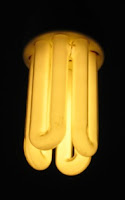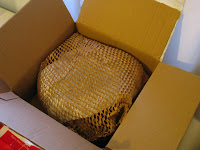The short version (my "elevator pitch"):
Compact fluorescent lamps (CFLs) use about a fifth of the energy of a normal (incandescent) bulb to produce the same amount of light, so switching to CFLs means more money in your pocket every month (lower energy bills). Even though they are more expensive to purchase, the upfront cost of a CFL is recovered within six to twelve months (depending on the price of your electricity). Incandescent bulbs only last for about eight months, while CFLs can last for up to 4 years or longer, which is an extra saving (fewer bulb replacements).
A lot of people say they do not like CFLs because the light is not nice, they flicker, and take time to warm–up. With the new CFLs all of these problems have been solved. They have quick start–up times, no flicker and good light quality. Make sure you choose a light marked "warm white" if you prefer the yellower colour of incandescents. CFL quality can vary quite a bit so buy a good quality bulb like the
Philips Genie or
Osram Dulux SuperStar.
The long version:
I am really passionate about energy conservation for a couple of reasons (which I'll talk about another time — one of the big ones is that it pays). So when I see people inventing technologies which I think will drive people away from good and practical ways of saving energy, something has to be done.
One of those bad ideas is the BC3 bulb which
Dan Lockton's posted about on his
blog. It forces people to choose expensive and difficult to find CFLs instead of just allowing them to choose what is best for them (
see my comments on Dan's blog).
Education, I believe, is the key to the solution, not controlling people's behaviour. As soon as you understand the huge benefits of CFLs the choice becomes easy.
I was having a conversation recently where I was explaining my passion for energy saving and I was using the example of compact fluorescent lights as a simple energy saving solution that is not generally used. The guy I was chatting to gave me the answer that I expect a lot of people would, "When they can make a CFL which gives the same light as a normal light bulb I'll change."
You probably feel the same way, the first picture that comes to your mind when you think of a CFL is a dimly lit room, and a light that takes a few minutes to get to "full power." Think again.
I believe that there are two critical issues which keep people away from using energy efficient light bulbs — light
quality and initial cost.
Unfortunately a bulbs ability to illuminate can not simple be measured by the wattage of the bulb. Firstly, CFLs have a higher efficiency than incandescents i.e. they are better at converting electrical energy into light — that means more light and less heat.
The more confusing thing is that not all light is equal. Light has two important properties: a colour temperature, and its ability to render colour accurately. Basically "warm" light (below 3200k) is yellower, and "cold" light (above 4000k) is bluer. Colour rendering index (CRI) is a measure of colour variation when compared to a reference (
for a nice summary I found this on Osram Sylvania, and
this on LightSearch). Incandescents typically produce warm white light and have a near perfect CRI, while CFLs are often cool white and have lower CRIs. Many new CFLs do have warm white light and higher CRIs, and the light they produce is comparable to incandescents.
I have yet to see a CFL that is marked with the CRI, so when you are standing in a store the best thing to look out for is the light colour which should be marked on the packaging (normally it will say "warm white" or "cool white" — if this is missing then the light is probably cool white). Also, buy a better CFL rather than the cheapest one.
The higher quality CFLs, like the
Philips Genie or
Osram Dulux SuperStar, are more expensive, but you can expect to get a longer lifetime, as well as a higher quality light — including flicker free start–up and short warm–up times. The price difference is really insignificant when you look at the lifetime of the bulbs.
So how much do you save, and how quickly do you recover the costs of the bulb? This varies from country to country depending on the price of electricity, as well as the price of the bulbs. Obviously the higher the cost of your electricity the faster you will recover the costs of the bulb and start saving.
South Africa happens to have some of the cheapest electricity in the world at about 0.43ZAR/kWh (kilowatt hour), but even for us the extra cost of the bulb is quickly recovered. In fact, if your light is on for 3 hours a day, and you replace a 100W incandescent with a 18W CFL, it only takes about 7 months to recover the initial costs, and you still have 60 months of savings to go (for a 6000hr lifetime bulb).
I have set up
a little spreadsheet that you can use to calculate the savings (let me know if you spot any errors). I think that switching to energy saving technologies makes so much economic sense that I even sent a
"Tip for Trevor".
The conclusionYou can put money back into your pocket, AND have good light — what more needs to be said? It is definitely worth trying out one of the new CFLs. Start today.
For lots of information about light, and lighting have a look at
LightSearch's light guides.
[Update] I came across this on Digg,
10 things worth knowing about CFLs.
[Update] Just a quick comment on the burden on the planet (
which Arash mentioned). I am trying to avoid making energy savings about reducing carbon emissions for a couple of reasons, mainly that I am not particularly convinced that this argument is going to change a lot of people's actions.
Seth has some things to say about More or Less. There are some more compelling (and also more frightening) reasons to act other than carbon emissions reductions. More to come on this, but for now have a
look at this.
Technorati tags : cfl, compact fluorescent, energy efficiency, incandescent, lighting. Trackback
 I found out that today is Blog Action Day while reading through my feeds this morning — I've clearly been sleeping. So my small contribution for today is to try to amplify a simple and important message.
I found out that today is Blog Action Day while reading through my feeds this morning — I've clearly been sleeping. So my small contribution for today is to try to amplify a simple and important message.










